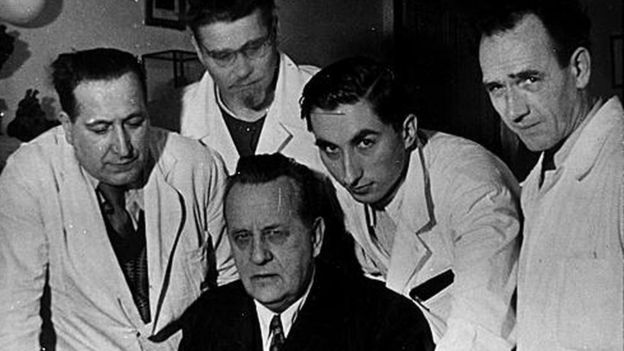Eduard Pernkopf: The Nazi book of anatomy still used by surgeons

When nerve surgeon Dr Susan Mackinnon needed help to finish an operation, she reached, as she often does, for a mid-20th Century book of anatomy.Thanks to the complex hand-drawn illustrations – showing the human body peeled back layer by layer – Dr Mackinnon, from Washington University in St Louis, was able to complete the procedure.
The book she had used, the innocuous-sounding Pernkopf Topographic Anatomy of Man, is widely considered to be the best example of anatomical drawings in the world. It is richer in detail and more vivid in colour than any other.Skin, muscle, tendons, nerves, organs and bone are revealed in graphic detail. It’s not for the faint-hearted.
But the book, often referred to as Pernkopf’s Atlas, is no longer in print and a second-hand set – there are several volumes – can sell for thousands of pounds online.Yet despite its hefty asking price, few would proudly display it in their clinic, library or home.That’s because the book’s findings came from the bodies of hundreds of people killed by the Nazis. It is their bodies – cut up and dissected – that are shown across thousands of pages.Critics say the book is tainted by its dark past and scientists have grappled with the ethics involved in its use.
Dr Mackinnon says she feels uncomfortable with its origin, but using the book is a crucial part of being an “ethical surgeon” – and that she could not do her job without it.Rabbi Joseph Polak – a Holocaust survivor and professor of health law – believes the book is a “moral enigma” because it is derived from “real evil, but can be used in the service of good”.
The book was a 20-year project of a prominent Nazi and doctor, Eduard Pernkopf, who rose through the academic ranks in Austria thanks to his support for Adolf Hitler’s party.His colleagues described him as an “ardent” National Socialist who, from 1938, wore a Nazi uniform to work every day.When he was made dean of the medical school at the University of Vienna, he sacked all the Jewish members of the faculty, including three Nobel laureates.
In 1939, a new Third Reich law ensured the bodies of all executed prisoners were immediately sent to the nearest department of anatomy for research and teaching purposes.During this period Pernkopf worked 18-hour days dissecting corpses, while a team of artists created images for his book. Sometimes the anatomy institute was so full, executions had to be postponed.Dr Sabine Hildebrandt, from Harvard Medical School, says at least half of the 800 images in the atlas came from political prisoners. They included gay men and lesbians, gypsies, political dissidents and Jews.
In the first edition of the atlas, published in 1937, the signatures of illustrators Erich Lepier and Karl Endtresser included swastikas and the double lightning bolt insignia of the SS.Even the 1964 two-volume English language edition included the original signatures including the Nazi symbols. Later editions airbrushed out the Nazi insignia.
Thousands of copies of the atlas were sold across the world, and it was translated into five languages. Prefaces and introductions in the books describe “pictorially impressive drawings… and outstanding pieces of art” while eschewing any mention of their bloody past.It was only in the 1990s that students and academics really began questioning who the people in the atlas were. After the brutal history was revealed, the atlas went out of publication in 1994.
The Royal College of Surgeons says the atlas is not in use in the UK, apart from being retained by libraries for historical purposes.However a recent Neurosurgery survey of nerve surgeons found 59% were aware of Pernkopf’s Atlas, with 13% currently using it.Of those surveyed, 69% said they were comfortable using the atlas once they were made aware of its history, 15% were uncomfortable and 17% were undecided.
Dr Mackinnon says nothing else “even begins to compare” to the book’s accuracy and detail, and it is particularly useful for complex surgeries because it helps her “figure out which of the many small nerves that course through our body are potentially causing the pain”.But she says she ensures everyone involved in the surgery is aware of the book’s dark origins.
“When I became aware of the tainted and evil origin of this atlas I began keeping it secured away in my operating room locker,” she says.
Last year, Rabbi Polak and medical historian and psychiatrist Professor Michael Grodin, prepared a Responsum (a scholarly answer based on Jewish medical ethics) on whether it is ethical to use the atlas based on Dr Mackinnon’s experience.They concluded that most Jewish authorities would allow the use of the images to save human lives – under the condition the history of the atlas was made known, so the victims were afforded some of the dignity they are owed.
Rabbi Polak, told the BBC: “Look at Dr Mackinnon – she couldn’t find a nerve and she’s the greatest in her field. The patient told her ‘I want my leg cut off if you can’t find it’ – no one wants that to happen.”So she swallowed hard and asked them to bring Pernkopf’s atlas. She found the nerve in minutes because of these illustrations.
“She asked me, as a moral thinker, about the situation. And I said to her, if this is going to heal this person and give them their life back, then there is no question that the atlas can be used.”Pernkopf was arrested after the war and sacked from the university. He was held at an Allied prison of war camp for three years but was never charged with any crime.
Following his release he returned to the university and continued his work on the atlas, publishing a third volume in 1952. He died in 1955, shortly before the publication of a fourth volume.More than 60 years later, the atlas is still one of the best resources for visual information for detailed anatomical and surgical work, according to Dr Hildebrandt, who teaches anatomy.
“Those of us who have learned to ‘see’ with it use it whenever we have questions. In peripheral nerve surgery some surgeons find it to be a unique and irreplaceable source of information,” she says.But, she adds: “I personally do not use the Pernkopf images in my anatomy teaching unless I have time to speak about its history.”
Dr Jonathan Ives, a bioethicist from the University of Bristol, agrees the atlas is “amazingly detailed” but says it is tainted by its “horrific past”.”If we are using it and reaping the benefits it implies we are somehow complicit,” he says.”But you could also argue that in not using it, the atlas would be lost and it could not be used as a reminder of what happened.”
For Dr Mackinnon, it remains an vital tool – even if its past can never be forgotten.”I would think that as an ethical surgeon I would take it as a given that I should use whatever educational resource I thought would help me to maximize a successful outcome,” she says, “and that my patient would expect that of me.
“In my experience, it would set back detailed nerve surgery tremendously if these books are lost.”





